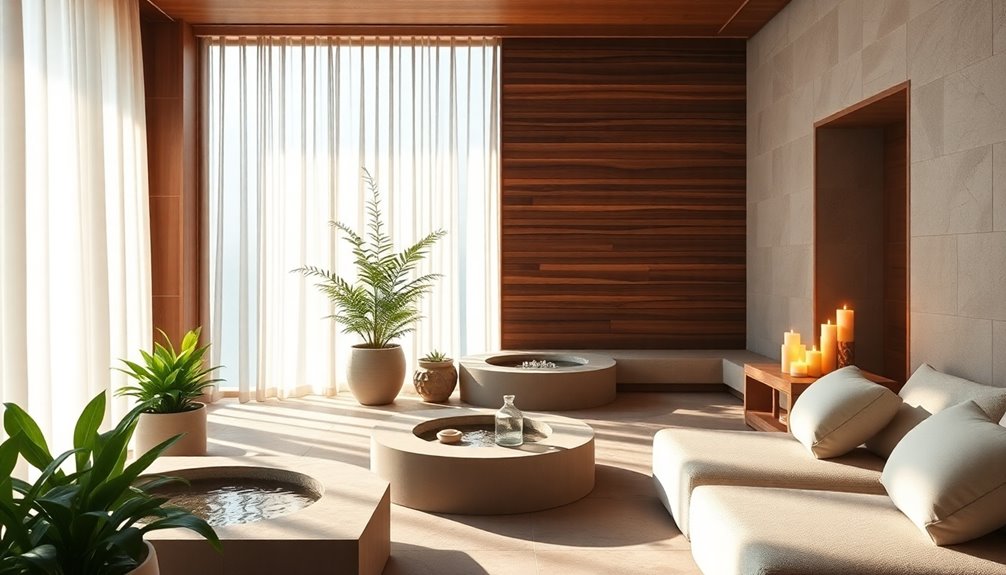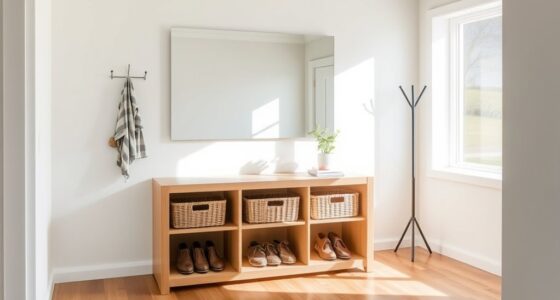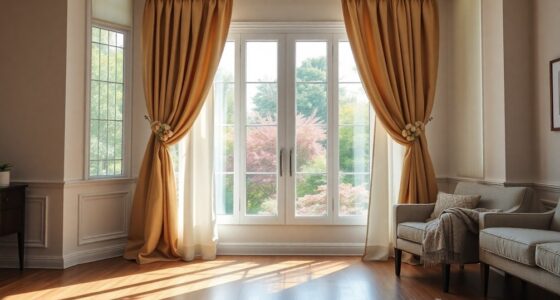When crafting the ultimate relaxation space in your spa, focus on intentional design choices that prioritize comfort and tranquility. Start with a welcoming reception area and private treatment rooms that guarantee privacy. Organize relaxation zones near treatment spaces to create a seamless experience. Incorporate soothing colors, layered lighting, and natural elements to enhance ambiance. Don't forget the importance of sensory elements like aromatherapy and fresh flowers to elevate the overall atmosphere. By considering these key elements, you'll guide guests toward a rejuvenating experience that keeps them coming back. Discover more insights that can transform your space even further.
Key Takeaways
- Design a welcoming reception area with clear signage to reduce guest anxiety and create a positive first impression.
- Ensure treatment rooms prioritize privacy and soundproofing for an enhanced relaxation experience.
- Incorporate natural elements and soothing color schemes throughout the spa to promote tranquility and connection to nature.
- Utilize layered lighting and aromatherapy to create a versatile ambiance that caters to various activities and enhances sensory experiences.
- Consider open concept designs and private suites to balance social interaction with personal relaxation, accommodating diverse client needs.
Importance of Spa Design

When you step into a spa, the design instantly sets the tone for your experience. Effective spa design enhances the guest experience by promoting relaxation through intentional spatial planning and aesthetics.
By incorporating natural elements like plants and water features, you create a calming atmosphere that improves air quality. Proper zoning within the spa minimizes noise pollution, allowing you to unwind in tranquil relaxation zones.
A cohesive design theme, supported by soothing color schemes and appropriate lighting, establishes a luxurious environment that invites you to escape life's stresses.
Ultimately, thoughtful spa design not only enhances your satisfaction but also guarantees that every element works in harmony to provide an unforgettable experience.
Key Elements of Spa Layout

When designing your spa layout, focus on creating a welcoming reception area that sets a positive tone for guests.
Make certain your treatment rooms offer privacy and soundproofing for a truly relaxing experience.
Finally, strategically placing relaxation zones near the treatment areas makes it easy for clients to unwind after their sessions.
Welcoming Reception Area
A welcoming reception area is essential for setting the tone of your spa, as it creates the first impression guests will have upon arrival. Guarantee the space is spacious and features comfortable seating to encourage relaxation. Incorporate natural elements, like indoor plants and water features, to enhance tranquility.
Here's a quick guide to key elements:
| Element | Purpose | Impact |
|---|---|---|
| Comfortable Seating | Encourages relaxation | Positive first impression |
| Natural Elements | Promotes tranquility | Calming environment |
| Refreshment Station | Elevates guest experience | Wellness-focused |
| Soothing Color Schemes | Creates a calming atmosphere | Enhances ambiance |
| Clear Signage | Facilitates navigation | Reduces stress |
Private Treatment Rooms
The atmosphere created in the reception area naturally flows into the private treatment rooms, which are vital for delivering a serene spa experience.
These rooms should feature soundproofing to guarantee privacy and minimize external noise, enhancing relaxation. High-quality furnishings, including plush massage tables and ergonomic chairs, maximize client comfort during treatments.
A spacious layout is important for easy movement, accommodating various treatment modalities like massages and facials. Incorporating adjustable lighting and calming color schemes helps create a soothing atmosphere that fosters tranquility.
Additionally, access to essential amenities, such as sinks and storage for linens, guarantees a hygienic environment, allowing therapists to maintain efficiency while focusing on providing an exceptional experience for clients.
Relaxation Zones Access
Strategically positioning relaxation zones is key to enhancing the overall spa experience. These areas should be easily accessible from treatment areas, allowing clients to shift smoothly.
To create the ideal relaxation zone, consider the following elements:
- Comfortable seating and soft furnishings for extended stays
- Natural elements like plants and water features for a calming atmosphere
- Clear pathways and effective signage to guide guests effortlessly
- Privacy considerations, including soundproofing and visual barriers, to guarantee tranquility
- A serene ambiance that promotes relaxation and peace
Incorporating these key factors won't only enhance guest comfort but also cultivate a truly rejuvenating environment.
Prioritizing these considerations will elevate the entire spa experience.
Popular Spa Layout Ideas

While designing a spa layout, consider how different elements can work together to enhance your guests' experience. Open concept designs encourage social interaction, allowing guests to enjoy shared relaxation experiences while maintaining tranquil zones.
For a more intimate experience, private suites provide personalized services and exclusive amenities for couples or small groups. Integrating outdoor spaces, like gardens or patios, creates a natural ambiance that promotes relaxation.
Multi-functional treatment rooms maximize efficiency by accommodating diverse guest needs, offering everything from massages to yoga sessions. Finally, combining wellness areas with relaxation zones fosters a holistic approach to health, appealing to a broader clientele and ensuring everyone finds their perfect retreat.
Design Aesthetics and Ambiance

Creating an inviting atmosphere is essential for any spa, as it directly impacts your guests' overall experience.
To craft the perfect design aesthetics and ambiance, focus on these elements:
- Soothing color scheme: Opt for soft, neutral tones like beige, pale blue, and sage green.
- Layered lighting: Use ambient, task, and accent lighting to create a versatile atmosphere.
- Natural materials: Incorporate wood, stone, and indoor plants to enhance a connection to nature.
- Aromatherapy: Infuse calming scents with essential oils to elevate the sensory experience.
- Thoughtful decor: Curate art and decor that reflects your spa's theme, promoting tranquility.
Additionally, consider offering beverages like mushroom coffee, which contains adaptogenic properties that help reduce stress and enhance the overall relaxation experience.
Trends in Spa Design

As the spa industry evolves, it's essential to stay attuned to the latest trends in design that enhance guest experiences.
You'll notice a growing emphasis on wellness and holistic treatments, with many establishments incorporating practices like yoga and meditation.
Sustainable design is also on the rise, as spas increasingly choose eco-friendly materials and energy-efficient systems to reduce their environmental impact.
Technology integration plays a significant role too, allowing for customizable ambiance through smart lighting and sound systems.
Furthermore, customization options empower you to tailor treatments to your preferences.
Finally, multi-functional spaces create versatile environments that accommodate various services, promoting relaxation and overall wellness.
Embracing these trends can elevate your spa's appeal and effectiveness.
Comfort and Quality Considerations

Comfort and quality are paramount in spa layout design, directly influencing client satisfaction and relaxation.
To create the ultimate luxury experience, consider these essential elements:
- Natural materials like wood and stone for a soothing environment
- Comfortable lounge areas with soft seating for unwinding
- Quality linens and fresh towels for hygiene and comfort
- Adjustable lighting to customize the atmosphere
- Ergonomically designed chairs and plush massage tables for ideal relaxation
Incorporating best home security systems can enhance guest safety while they enjoy their time at the spa.
Final Touches for Relaxation

While every aspect of a spa contributes to relaxation, the final touches truly elevate the experience.
Soft music, played at a gentle volume, creates tranquility and masks external noise, allowing you to unwind completely. Surrounding yourself with calming artwork—think nature scenes or soothing abstracts—helps to ease your mind.
In relaxation areas, warm blankets and plush cushions offer that extra layer of comfort, making you feel cozy and secure.
Don't overlook the importance of attention to detail; fresh flowers and scented candles not only beautify the space but also enhance your sensory experience. Incorporating essential oils can further promote relaxation and reduce anxiety, enriching the overall ambiance.
These thoughtful elements considerably boost client satisfaction, ensuring that every visit becomes a cherished escape, encouraging you to return for more moments of bliss.
Frequently Asked Questions
How Can I Incorporate Plants Into My Spa Design?
To incorporate plants into your spa design, start by selecting low-maintenance varieties like succulents or ferns.
Place them in strategic spots, such as near windows or in corners, to enhance natural light.
Use varying heights by adding tall plants on stands and smaller ones on shelves.
You can also create a calming atmosphere with hanging planters.
Remember to choose pots that complement your overall decor, ensuring a cohesive and tranquil environment.
What Are Budget-Friendly Spa Layout Ideas?
When you're planning a budget-friendly spa layout, think about multifunctional spaces.
You can use simple partitions to create private areas without major renovations. Incorporate natural light with sheer curtains, and opt for affordable decor like DIY art or thrifted items.
Use plants to enhance the atmosphere without breaking the bank. Strategically place seating to encourage relaxation while maximizing your space.
Focus on creating a calming environment that feels luxurious, even on a budget.
How Can Sound Impact the Spa Experience?
Imagine walking into a serene oasis where every sound wraps around you like a warm blanket.
Sound plays an essential role in shaping your spa experience. Calming music or gentle nature sounds can transport you to a tranquil state, while loud, jarring noises can create stress.
You'll find that the right acoustics can enhance relaxation, allowing you to fully immerse yourself in the soothing environment designed for rejuvenation and peace.
What Lighting Options Enhance Relaxation in a Spa?
To enhance relaxation in a spa, you'll want to focus on soft, warm lighting.
Consider using dimmable fixtures or lamps with warm bulbs to create a cozy atmosphere. Incorporating candles can also add a calming glow and pleasant scents.
Additionally, you might try LED lights that change colors, as gentle shifts can evoke tranquility.
How to Maintain Cleanliness in a Home Spa?
To maintain cleanliness in your home spa, start by creating a regular cleaning schedule.
Wipe down surfaces with disinfectant after each use, and don't forget to clean towels and robes frequently.
You should also invest in quality cleaning supplies, like a good vacuum or mop for floors.
Keep your spa well-ventilated to prevent mold.
Finally, encourage everyone to wash their hands before entering to help keep your space fresh and inviting.
Conclusion
In the world of spa design, every detail counts, weaving together a tapestry of tranquility. By embracing the key elements and trends we've explored, you're not just creating a space—you're crafting an oasis where stress melts away like ice in the sun. So, let your imagination flow and infuse your unique touch; the ultimate relaxation space is within reach. It's time to transform your vision into a serene retreat that invites rejuvenation and peace.









